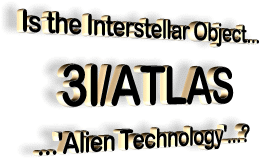|

by Avi Loeb
July 16, 2025
from
AviLoeb Website
|
Avi Loeb
is the head of the
Galileo Project, founding director of 'Harvard
University's - Black Hole Initiative,' director of the
Institute for Theory and Computation at the
Harvard-Smithsonian Center for Astrophysics, and the
former chair of the astronomy department at Harvard
University (2011-2020).
He is a former
member of the President's Council of Advisors on Science
and Technology and a former chair of the Board on
Physics and Astronomy of the National Academies.
He is the
bestselling author of "Extraterrestrial
- The First Sign of Intelligent Life Beyond Earth"
and a co-author of the textbook "Life
in the Cosmos", both published in 2021.
His new book, "Interstellar",
was published in August 2024. |

Image credit:
Stefan Kierek
Today I co-authored an intriguing new paper (Is
the Interstellar Object 3I/ATLAS Alien Technology?)
with the brilliant collaborators Adam Hibberd and Adam
Crowl from the
Initiative for Interstellar Studies
in London, UK.
One of the solutions to Enrico Fermi's question about
extraterrestrials, "where
is everybody?" is offered by the dark forest hypothesis,
popularized by Cixin Liu's science fiction novel "The
Dark Forest."
This hypothesis proposes that our cosmic
neighborhood is dangerous, filled with
intelligent civilizations
that are hostile and silent to avoid detection by potential
predators.
In this context, the silence in searches for radio
signals by the SETI community is not caused by the lack of
extraterrestrial intelligent civilizations, but is instead a
consequence of them fearing mutual destruction.
Our paper explores the possibility that the recently discovered
interstellar object,
3I/ATLAS, may provide evidence in
support of the dark forest hypothesis.
This new interstellar
interloper has displayed a number of anomalous characteristics, some
of which were summarized in an essay that I wrote shortly after its
discovery.
In particular:
-
The retrograde orbital plane (defined by the orbital angular
momentum vector) of 3I/ATLAS around the Sun lies within 5 degrees of
that of Earth - the so-called
ecliptic plane.
The likelihood for
that coincidence out of all random orientations is 0.2%.
-
As I showed in a
recent paper, the brightness of
3I/ATLAS implies an object that is ~20 kilometers in diameter (for a
typical albedo of ~5%), too large for an interstellar asteroid.
We
should have detected a million objects below the ~100-meters scale
of the first reported interstellar object 1I/'Oumuamua
for each ~20-kilometer object.
-
No spectral features of cometary gas are found in spectroscopic
observations of 3I/ATLAS.
The detected reddening of reflected
sunlight could originate from the surface of the object. Related
data can be found
here and
here.
The fuzz observed around
3I/ATLAS (see images
here,
here and
here) is inconclusive given the
motion of the object and the inevitable smearing of its image over
the exposure time.
-
For its orbital parameters, 3I/ATLAS is synchronized to approach
unusually close to Venus (0.65au where 1au is the Earth-Sun
separation), Mars (0.19au) and Jupiter (0.36au), with a cumulative
probability of 0.005% relative to orbits with the same orbital
parameters but a random arrival time.
-
3I/ATLAS achieves perihelion on the opposite side of the Sun
relative to Earth.
This could be intentional to avoid detailed
observations from Earth-based telescopes when the object is
brightest or when gadgets are sent to Earth from that hidden vantage
point.
The retrograde trajectory at a perihelion speed of
68
kilometers per second, opposite to the direction of motion of the
Earth around the Sun at 30 kilometers per second, makes the velocity
difference between Earth and 3I/ATLAS 98 kilometers per second.
It
is therefore impractical for earthlings to land on 3I/ATLAS at
closest approach by boarding chemical rockets, since our best
rockets reach at most a third of that speed.
-
The optimal point for a reverse Solar
Oberth maneuver to become bound to
the Sun is at perihelion.
In an Oberth maneuver, the thrust of a
spacecraft is applied at its maximum orbital speed, namely at
periapsis, so as to maximize the resulting change in kinetic energy.
This applies both to accelerating to achieve Solar System escape, or
alternatively to slow down from a high speed (a 'reverse Oberth
maneuver') in order to break, stay bound to the Sun and potentially
visit a planet like Earth.
It is this optimal breaking point for
3I/ATLAS that is obscured from our view by the Sun.
-
The direction from where 3I/ATLAS is coming is oriented towards
the bright Milky-Way center, where crowding by background stars made
its detection difficult prior to July 2025.
Figures 1 and 2 in
our paper show that if astronomers
were to detect 3I/ATLAS more than a year earlier, then we would have
had an opportunity to launch a spacecraft that could have
intercepted 3I/ATLAS along its path.
By now, such an interception is
not feasible with chemical rockets.
-
The velocity thrusts needed for launches of gadgets out of
3I/ATLAS to intercept Venus, Mars, or Jupiter are smaller than 5
kilometers per second, achievable by intercontinental ballistic
missiles.
The near alignment of the retrograde trajectory of 3I/ATLAS with the
ecliptic plane offers various benefits to an extraterrestrial
intelligence, since it allows a spacecraft to access Earth with
relative impunity.
The eclipse of 3I/ATLAS by the Sun at perihelion
for observers at Earth, would allow a spacecraft to conduct a
clandestine reverse Solar Oberth maneuver, an optimal high-thrust
strategy for interstellar spacecraft to brake and stay bound to the
Sun.
An optimal intercept of Earth would entail an arrival in late
November or early December of 2025.
Detection of a non-gravitational
acceleration could also indicate an intent to intercept Jupiter, not
far off the path of 3I/ATLAS, and a strategy to rendezvous with it
after perihelion.
Our paper is contingent on a
remarkable but testable hypothesis that 3I/ATLAS is a functioning
technological artifact, to which I and my two co-authors do not
necessarily ascribe.
Yet, this hypothesis is worthy of a scientific
analysis for two reasons:
-
The consequences, should the hypothesis turn out to be correct,
could potentially be dire for humanity, and would possibly require
defensive measures to be undertaken (though these might prove
futile).
-
The hypothesis is an interesting exercise in its own right, and
is fun to explore, irrespective of its likely validity.
Given its interstellar speed of 60 kilometers per second, 3I/ATLAS
entered the outer boundary of the Solar System (at 100,000 times the
Earth-Sun separation) about 8,000 years ago...!
This was roughly when
human-made technologies became advanced enough to start documenting
history on Earth.
If the hypothesis about a technological artifact ends up being
correct, then there are two possible implications:
In the first case, humanity need not do anything but await
the arrival of this interstellar messenger with open arms.
It is the
second option which is of great concern.
Given the dramatic implications of the second possibility, we can
apply the logic of
Pascal's wager that suggested,
it is
more rational to believe in God's existence than not.
The insight
offered by the mathematician Blaise Pascal was that,
the potential
benefits of believing (in our case - alerting humanity to the
existential risk from 3I/ATLAS) far outweigh the potential losses
(in our case - a theoretical idea that does not describe reality),
while the potential losses of not believing are far greater than the
potential benefits.
Our paper is largely a pedagogical exercise, with interesting
realizations worthy of a record in the scientific literature.
By
far, the most likely outcome will be that 3I/ATLAS is a completely
natural interstellar object, probably a comet, and we await the
astronomical data to support this likely origin.
Nevertheless, when viewed from an open-minded and unprejudiced
perspective, our paper includes many compelling insights that could
be applied to tens of interstellar objects that are expected to be
detected over the next decade by the
Vera C. Rubin observatory.
The existential risk from
alien intelligence (external A.I.) is not
discussed as often as other existential risks, like artificial
intelligence (our A.I.).
In a dark forest, uncertainties about one's
relative strength may argue for hiding as a survival mechanism,
especially if a civilization was bruised in the past.
In addition,
dominance could be time dependent as there might always be some
rising young technological civilization which becomes powerful
quickly - requiring reconnaissance missions on trajectories similar
to that of 3I/ATLAS.
We might soon realize that the extension of natural selection to
interstellar space involves survival of the fittest.
In a
recent essay (Spacecraft
from Interstellar Rocks?), I provided a menu of
methods for distinguishing an extraterrestrial spacecraft from an
interstellar rock. Here's hoping that this menu will be used by
other astronomers.
Ignoring the technological option is not a sign
of intelligence...
|


